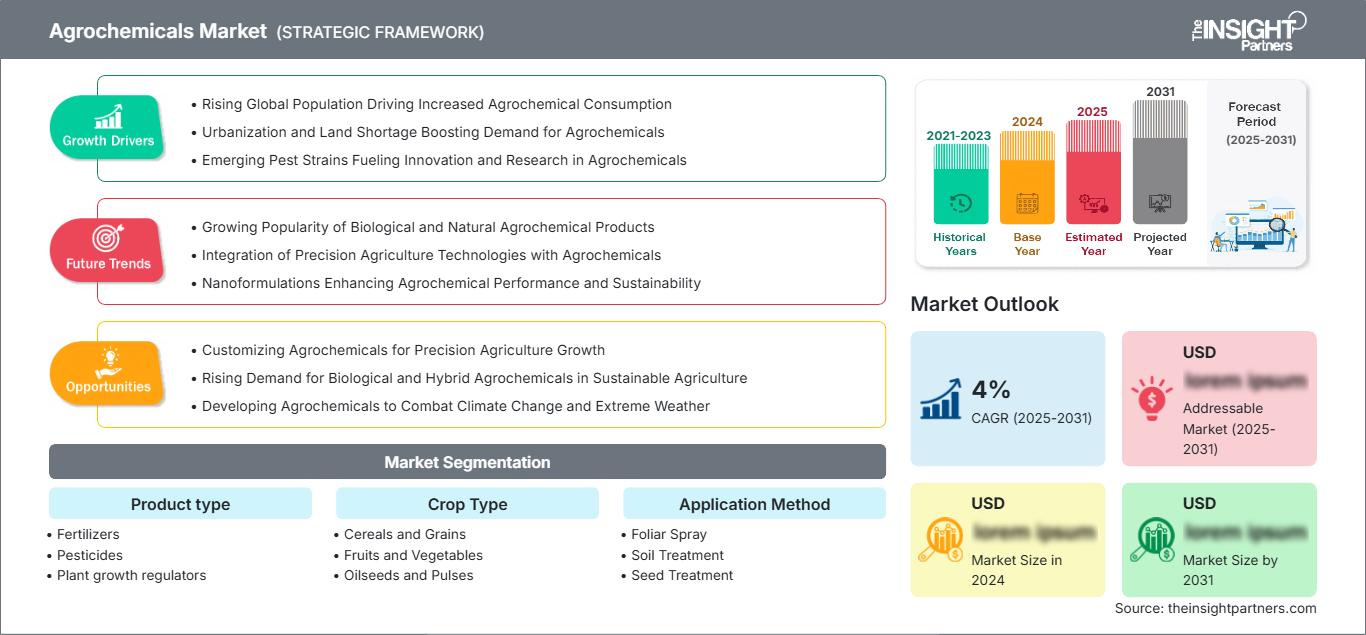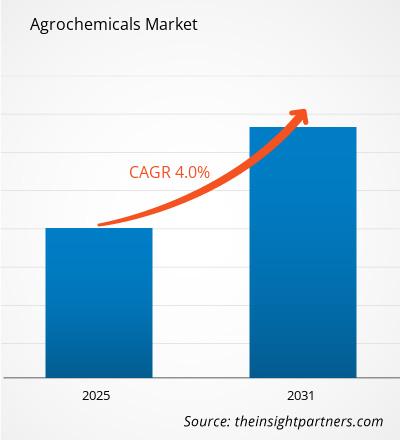Se prevé que el mercado de agroquímicos registre una tasa de crecimiento anual compuesta (TCAC) del 4% entre 2025 y 2031, con un tamaño de mercado que se expandirá de XX millones de dólares estadounidenses en 2024 a XX millones de dólares estadounidenses en 2031.
El informe se segmenta por tipo de producto (fertilizantes, plaguicidas, reguladores del crecimiento vegetal y otros). Además, presenta un análisis basado en el tipo de cultivo (cereales, frutas y hortalizas, oleaginosas y legumbres, y otros). El análisis global se desglosa a nivel regional y por países principales. El alcance del informe abarca el tamaño del mercado y las previsiones a nivel global, regional y nacional para todos los segmentos clave. El informe ofrece el valor en USD para los análisis y segmentos mencionados. Asimismo, proporciona estadísticas clave sobre la situación del mercado de los principales actores y presenta las tendencias y oportunidades del mercado.
Propósito del Informe
El informe sobre el mercado de agroquímicos de The Insight Partners tiene como objetivo describir el panorama actual y el crecimiento futuro, los principales factores impulsores, los desafíos y las oportunidades. Esto proporcionará información valiosa a diversos actores del sector, tales como:
- Proveedores/fabricantes de tecnología: Para comprender la evolución de la dinámica del mercado y conocer las posibles oportunidades de crecimiento, lo que les permitirá tomar decisiones estratégicas informadas.
- Inversores: Realizar un análisis exhaustivo de las tendencias relativas a la tasa de crecimiento del mercado, las proyecciones financieras del mercado y las oportunidades que existen a lo largo de la cadena de valor.
- Organismos reguladores: Regular las políticas y controlar las actividades en el mercado con el objetivo de minimizar los abusos, preservar la confianza de los inversores y mantener la integridad y la estabilidad del mercado.
Segmentación del mercado de agroquímicos
Tipo de producto
- Fertilizantes
- pesticidas
- Reguladores del crecimiento de las plantas
Tipo de cultivo
- Cereales y granos
- Frutas y verduras
- Oleaginosas y legumbres
Método de aplicación
- Spray foliar
- Tratamiento del suelo
- Tratamiento de semillas
Geografía
- América del norte
- Europa
- Asia-Pacífico
- América del Sur y Central
- Oriente Medio y África
Obtendrá personalización gratuita de cualquier informe, incluyendo partes de este informe, análisis a nivel de país y paquetes de datos de Excel. Además, podrá aprovechar excelentes ofertas y descuentos para empresas emergentes y universidades.
Mercado de agroquímicos: Perspectivas estratégicas

-
Obtenga las principales tendencias clave del mercado que se describen en este informe.Esta muestra GRATUITA incluirá análisis de datos, desde tendencias del mercado hasta estimaciones y pronósticos.
Factores que impulsan el crecimiento del mercado de agroquímicos
- El aumento de la población mundial impulsa el consumo de agroquímicos: El crecimiento de la población mundial y la creciente necesidad de alimentos son los principales factores que impulsan el consumo global de agroquímicos. Desde el punto de vista económico, los agricultores deben aumentar la producción agrícola ante la alta demanda, lo que a menudo conlleva el uso de agroquímicos para incrementar la productividad.
- La urbanización y la escasez de tierras impulsan la demanda de agroquímicos: Con la expansión urbana e industrial que reduce la disponibilidad de tierras cultivables, se ha vuelto cada vez más importante aumentar la producción de las tierras existentes. Es aquí donde los agroquímicos resultan útiles, al facilitar el cultivo intensivo en las pequeñas superficies disponibles.
- Las nuevas cepas de plagas impulsan la innovación y la investigación en agroquímicos: Las nuevas infestaciones de cultivos y las nuevas cepas de plagas que pueden resistir los productos químicos ya disponibles exigen un cambio constante en los agroquímicos que se utilizan, lo que incrementa la labor de investigación en el sector.
Tendencias futuras del mercado de agroquímicos
- Mayor popularidad de los productos agroquímicos biológicos y naturales: El uso de productos biológicos y naturales en la agricultura está cobrando cada vez más importancia. Algunos de estos agentes biológicos son biopesticidas, bioestimulantes y otros productos de base biológica, cuyo uso se está extendiendo debido a su seguridad y ventajas medioambientales.
- Integración de tecnologías de agricultura de precisión con agroquímicos: Una de las principales tendencias ha sido la aplicación de agroquímicos junto con tecnologías de agricultura de precisión. Equipos de pulverización inteligentes, sistemas de aplicación con drones y sistemas de IA para la gestión del uso de productos químicos son algunas de las innovaciones que se engloban dentro de esta definición.
- Nanoformulaciones que mejoran el rendimiento y la sostenibilidad de los agroquímicos: El uso de nanoformulaciones de agroquímicos es una técnica novedosa. Esto ofrece ventajas como un mejor rendimiento, una liberación controlada y una menor contaminación.
Oportunidades de mercado de agroquímicos
- Adaptación de agroquímicos para el crecimiento de la agricultura de precisión: Existe un amplio potencial para el desarrollo de agroquímicos adaptados a la agricultura de precisión. Esto incluye formulaciones compatibles con sistemas de aplicación de dosis variable, sistemas de pulverización con drones y sistemas de gestión agrícola con inteligencia artificial.
- Aumento de la demanda de agroquímicos biológicos e híbridos en la agricultura sostenible: Actualmente, también existen oportunidades para los agroquímicos biológicos y sus híbridos, en línea con la tendencia de la agricultura sostenible.
- Desarrollo de agroquímicos para combatir el cambio climático y los fenómenos meteorológicos extremos: El calentamiento global en la agricultura ofrece la oportunidad de crear tipos específicos de agroquímicos diseñados para contrarrestar los efectos de los fenómenos meteorológicos extremos en los cultivos.
Perspectivas regionales del mercado de agroquímicos
Los analistas de The Insight Partners han explicado en detalle las tendencias y los factores regionales que influyen en el mercado de agroquímicos durante el período de previsión. Esta sección también analiza los segmentos del mercado de agroquímicos y su distribución geográfica en Norteamérica, Europa, Asia Pacífico, Oriente Medio y África, y Sudamérica y Centroamérica.
Alcance del informe de mercado de agroquímicos
| Atributo del informe | Detalles |
|---|---|
| Tamaño del mercado en 2024 | XX millones de dólares estadounidenses |
| Tamaño del mercado para 2031 | XX millones de dólares estadounidenses |
| Tasa de crecimiento anual compuesto global (2025 - 2031) | 4% |
| Datos históricos | 2021-2023 |
| período de previsión | 2025-2031 |
| Segmentos cubiertos |
Por tipo de producto
|
| Regiones y países cubiertos |
América del norte
|
| Líderes del mercado y perfiles de empresas clave |
|
Densidad de los actores del mercado de agroquímicos: comprensión de su impacto en la dinámica empresarial
El mercado de agroquímicos está creciendo rápidamente, impulsado por la creciente demanda de los usuarios finales debido a factores como la evolución de las preferencias de los consumidores, los avances tecnológicos y una mayor conciencia de los beneficios del producto. A medida que aumenta la demanda, las empresas amplían su oferta, innovan para satisfacer las necesidades de los consumidores y aprovechan las nuevas tendencias, lo que impulsa aún más el crecimiento del mercado.

- Obtenga una visión general de los principales actores del mercado de agroquímicos.
Puntos clave de venta
- Cobertura integral: El informe abarca de forma exhaustiva el análisis de productos, servicios, tipos y usuarios finales del mercado de agroquímicos, proporcionando una visión holística.
- Análisis de expertos: El informe se elabora a partir del profundo conocimiento de expertos y analistas del sector.
- Información actualizada: El informe garantiza su relevancia para el negocio gracias a su cobertura de información reciente y tendencias de datos.
- Opciones de personalización: Este informe se puede personalizar para satisfacer las necesidades específicas del cliente y adaptarse adecuadamente a las estrategias comerciales.
Por lo tanto, el informe de investigación sobre el mercado de agroquímicos puede ayudar a impulsar la comprensión del panorama de la industria y sus perspectivas de crecimiento. Si bien existen algunas preocupaciones válidas, los beneficios generales de este informe tienden a superar las desventajas.
- Análisis histórico (2 años), año base, pronóstico (7 años) con CAGR
- Análisis PEST y FODA
- Tamaño del mercado, valor/volumen: global, regional y nacional
- Industria y panorama competitivo
- Conjunto de datos de Excel
Informes recientes
Informes relacionados
Testimonios
Razón para comprar
- Toma de decisiones informada
- Comprensión de la dinámica del mercado
- Análisis competitivo
- Información sobre clientes
- Pronósticos del mercado
- Mitigación de riesgos
- Planificación estratégica
- Justificación de la inversión
- Identificación de mercados emergentes
- Mejora de las estrategias de marketing
- Impulso de la eficiencia operativa
- Alineación con las tendencias regulatorias






















 Obtenga una muestra gratuita para - Mercado de agroquímicos
Obtenga una muestra gratuita para - Mercado de agroquímicos